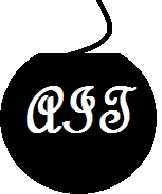There are two main types
1.Impulse steam turbine
2.Reaction steam turbine
Impulse steam turbine:
The basic idea of an impulse turbine is that a jet of steam from a fixed nozzle pushes against the rotor blades and impels them forward.
The velocity of steam is twice as fast as the velocity of blade.
Pressure drops take place in the fixed blade (nozzle).
The single stage impulse turbine:
The turbine consists of a single rotor to which impulse blades are attached.
The steam is fed through one or several convergent nozzles.
If high velocity of steam is allowed to flow through one row of moving blades.
It produces a rotor speed of about 30000 rpm which is too high for practical use.
In impulse the steam is expanded in fixed nozzles. The high velocity steam issuing from the nozzles does work on moving blades which causes the shaft to rotate.
Velocity diagram:
Reaction steam turbine:
A reaction turbine utilizes a jet of steam that flows from a nozzle on the rotor.
Actually, the steam is directed into the moving blades by fixed blades designed to expand the steam.
The result is a small increase in velocity over that of the moving blades.
Schematic diagram:
Difference Between Impulse and Reaction Turbine
Impulse Reaction
1-Pressure drops in nozzles and not in moving blade ⇒Pressure drops in fixed blade as well as in moving blades
2-Constant blade channel area ⇒Varying blade channel area
3-Profile type blades ⇒ Aerofoil type blades
4-Restricted round or incomplete admission of steam ⇒All round or complete admission
5-Diaphragm contains nozzles – ⇒Fixed blades similar to moving blades attached to casing serve as nozzles and guide the steam
6-Occupies less space for same power ⇒Occupies more space for same power
7-Higher efficiency in initial stage ⇒higher efficiency in final stages.
8-Suitable for small power requirements ⇒Suitable for medium or high power requirements.
9-Blade manufacturing is not difficult ⇒Blade manufacturing process is difficult.
10-Velocity of steam is high ⇒Velocity of steam is less.
Main components are
1.Casing
2.Rotor
3.Blades
4.Stop and control valve
5.Oil befell, steam befell
6. governor
7.Bearing(general and thrust bearing)
8.Gear box(epicyclic gear box)
9.Oil pumps






